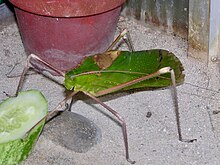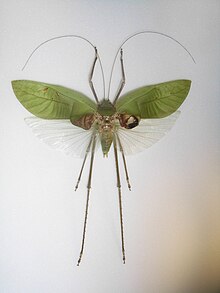|
Arachnacris corporalis
Arachnacris corporalis, the giant Malaysian katydid, giant long-legged katydid or giant katydid (not to be confused with Stilpnochlora couloniana, a species native to the United States), is a large species of bush cricket or katydid that is native to Malaysia.[1] It is the largest species of katydid in the world.[2] DescriptionThe giant Malaysian katydid is a large green insect that is, on average, about 6 inches long.[3] They have long, thin legs, like most katydids, with the hind legs being longer than the front two pairs of legs. They have long, leaf-like wings that help them stay camouflaged from predators, as they typically reside in trees and don't move very much. As they age, their coloration mimics a leaf, and the tips of their wings become brown to resemble the way that leaves rot.[4] The amount of brown on their wings can be used as a method to determine the age of the katydid, with more brown meaning an older age. Like all katydids, they make a loud chirping sound by scraping a toothed stridulatory file found near the base of one wing against a scraper located on the opposite wing.[5] They use this sound as a defense mechanism and to attract mates. Sexual dimorphismAdult males and females of the species are easily distinguished, as females have a green pronotum and males have a brown pronotum, which is the triangular segment at the dorsal base of their wings.[4] Life cycle and reproductionFemales have an ovipositor, which they use to lay their eggs in moss or rotting wood.[4] When they reach their adult stage, they start out bright green and, as they get older, the tips of their wings turn brown, leading to a larger brown patch the older the katydid is. They live for about 6 months in their adult stage.[4] Predator defenseTheir primary defense is camouflage due to their leaf-like coloration. To prevent being tracked down by scent, they throw their feces as far away from them as possible, usually to a neighboring bush or tree.[4] They can also use their loud chirping to scare away predators, as the volume is amplified due to their size. References
|
||||||||||||||||||||||||||||||||||||
Portal di Ensiklopedia Dunia

